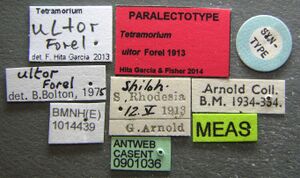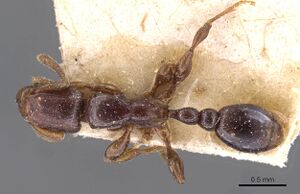Tetramorium ultor
| Tetramorium ultor | |
|---|---|

| |
| Scientific classification | |
| Kingdom: | Animalia |
| Phylum: | Arthropoda |
| Class: | Insecta |
| Order: | Hymenoptera |
| Family: | Formicidae |
| Subfamily: | Myrmicinae |
| Tribe: | Crematogastrini |
| Genus: | Tetramorium |
| Species: | T. ultor |
| Binomial name | |
| Tetramorium ultor Forel, 1913 | |
Limited sampling suggests this ant is ground dwelling, nests in or under rotten logs, and is termitophagous.
Identification
Hita Garcia & Fisher (2014) - A member of the Tetramorium decem species group. Tetramorium ultor can be recognised by the following combination of characters: relatively smaller species (WL 0.85–0.96); very large eyes (OI 33–36); propodeum armed with short teeth (PSLI 10–13); petiolar node in profile around 1.1 to 1.2 times higher than long (LPeI 86–92); dorsum of promesonotum unsculptured, smooth, and very shiny; body of uniform light to chestnut brown, appendages often lighter.
Since Bolton (1976) synonymised T. ultor under Tetramorium decem, almost all of the material of T. ultor examined here was identified and/or labelled as T. decem prior to this study. However, after careful examination of all the available material, we have come to the conclusion that T. ultor is distinctive enough to merit species status. Tetramorium ultor is smaller (WL 0.85–0.96), has shorter propodeal teeth (PSLI 10–13), a lower petiolar node, around 1.1 to 1.2 times higher than long (LPeI 86–92), and is of uniform light brown to chestnut brown body colouration. By contrast, T. decem is larger (WL 1.02–1.16), has longer propodeal spines (PSLI 17–19), a higher petiolar node, in profile around 1.2 to 1.3 times higher than long (LPeI 77–82), and is conspicuously bicoloured. In addition, both species share most of their distribution range without any intermediate forms. Furthermore, T. ultor is unlikely to be confused with Tetramorium raptor and Tetramorium uelense since the latter two have a conspicuously rugose/rugulose promesonotum, which is completely unsculptured, smooth and shiny in T. ultor. The last species of the group, Tetramorium venator, is the one most similar to T. ultor, and both species are allopatric. However, both species can be separated by eye size, colour, and a different habitat choice. Tetramorium venator has larger eyes (OI 37–40) and is of a much darker brown than T. ultor, which has smaller eyes (OI 33–36) and is of a lighter brown. In addition, the latter species is more arid-adapted, occurring in woodlands and dry forests while T. venator seems to be a forest specialist found in primary, secondary, or disturbed rainforests. We consider the above arguments as sufficient to justify the heterospecificity of both species. Further arguments are provided below in the description of T. venator.
Based on the available material, we did not observe an intraspecific variation in T. ultor.
Keys including this Species
Distribution
Tetramorium ultor is widespread in eastern and southern Africa. It is distributed from Kenya south to Mozambique, and also found in Zambia and Zimbabwe.
Latitudinal Distribution Pattern
Latitudinal Range: -4.383333° to -20.75°.
| North Temperate |
North Subtropical |
Tropical | South Subtropical |
South Temperate |
- Source: AntMaps
Distribution based on Regional Taxon Lists
Afrotropical Region: Kenya, Mozambique, United Republic of Tanzania, Zambia, Zambia, Zimbabwe (type locality), Zimbabwe (type locality).
Distribution based on AntMaps
Distribution based on AntWeb specimens
Check data from AntWeb
Countries Occupied
| Number of countries occupied by this species based on AntWiki Regional Taxon Lists. In general, fewer countries occupied indicates a narrower range, while more countries indicates a more widespread species. |

|
Estimated Abundance
| Relative abundance based on number of AntMaps records per species (this species within the purple bar). Fewer records (to the left) indicates a less abundant/encountered species while more records (to the right) indicates more abundant/encountered species. |

|
Habitat
Most localities are tropical dry forest habitats or miombo woodland.
Biology
Castes
Worker
Images from AntWeb
   
| |
| Worker. Specimen code casent0914086. Photographer Michele Esposito, uploaded by California Academy of Sciences. | Owned by CAS, San Francisco, CA, USA. |
   
| |
| Paralectotype of Tetramorium ultor. Worker. Specimen code casent0901036. Photographer Ryan Perry, uploaded by California Academy of Sciences. | Owned by NHMUK, London, UK. |
   
| |
| Lectotype of Tetramorium ultor. Worker. Specimen code casent0909197. Photographer Z. Lieberman, uploaded by California Academy of Sciences. | Owned by MHNG, Geneva, Switzerland. |
   
| |
| Worker. Specimen code casent0914085. Photographer Michele Esposito, uploaded by California Academy of Sciences. | Owned by NHMUK, London, UK. |
Nomenclature
The following information is derived from Barry Bolton's Online Catalogue of the Ants of the World.
- ultor. Tetramorium (Decamorium) decem var. ultor Forel, 1913j: 217 (w.) ZIMBABWE. Combination in Decamorium: Wheeler, W.M. 1922a: 906. Junior synonym of decem: Bolton, 1976: 298. Revived from synonymy and raised to species: Hita Garcia & Fisher, 2014: 90.
Unless otherwise noted the text for the remainder of this section is reported from the publication that includes the original description.
Description
Worker
Hita Garcia & Fisher (2014) - (N=25). HL 0.62–0.70 (0.66); HW 0.48–0.58 (0.53); SL 0.35–0.42 (0.37); EL 0.16–0.20 (0.19); PH 0.29–0.33 (0.30); PW 0.37–0.45 (0.41); WL 0.85–0.96 (0.89); PSL 0.07–0.09 (0.08); PTL 0.22–0.25 (0.24); PTH 0.25–0.29 (0.27); PTW 0.19–0.22 (0.20); PPL 0.19–0.23 (0.21); PPH 0.25–0.30 (0.27); PPW 0.24–0.30 (0.27); CI 77–82 (80); SI 67–73 (70); OI 33–36 (35); DMI 44–48 (46); LMI 32–35 (34); PSLI 10–13 (12); PeNI 46–50 (48); LPeI 86–92 (88); DPeI 79–86 (84); PpNI 60–71 (67); LPpI 73–81 (78); DPpI 126–132 (130); PPI 130–145 (139).
Head much longer than wide (CI 77–82); posterior head margin weakly concave. Anterior clypeal margin with distinct, but often shallow median impression. Frontal carinae strongly developed and noticeably raised forming dorsal margin of very well-developed antennal scrobes, curving down ventrally and anteriorly halfway between posterior eye margin and posterior head margin and forming posterior and ventral scrobe margins; antennal scrobes very well developed, deep and with clearly defined margins all around, median scrobal carina absent. Antennal scapes short, not reaching posterior head margin (SI 67–73). Eyes very large (OI 33–36). Mesosomal outline in profile relatively flat, long and low (LMI 32–35), moderately marginate from lateral to dorsal mesosoma; promesonotal suture absent; metanotal groove present and distinct, but relatively shallow. Propodeum armed with short, triangular, and mostly blunt teeth (PSLI 10–13), propodeal lobes short, triangular, and usually blunt, in profile usually longer and more voluminous than propodeal spines. Tibiae and femorae strongly swollen. Petiolar node nodiform with moderately rounded antero- and posterodorsal margins, in profile around 1.1 to 1.2 times higher than long (LPeI 86–92), anterior and posterior faces approximately parallel, anterodorsal and posterodorsal margins situated at about same height and equally angled, petiolar dorsum weakly convex; node in dorsal view around 1.1 to 1.2 times longer than wide (DPeI 79–86), in dorsal view pronotum between 2.0 to 2.2 times wider than petiolar node (PeNI 46–50). Postpetiole in profile globular, approximately 1.2 to 1.4 times higher than long (LPpI 73–81); in dorsal view around 1.3 times wider than long (DPpI 126–132), pronotum approximately 1.4 to 1.5 times wider than postpetiole (PpNI 60–71). Postpetiole in profile appearing less voluminous than petiolar node, postpetiole in dorsal view between 1.3 to 1.5 times wider than petiolar node (PPI 130–145). Mandibles and clypeus usually fully unsculptured, smooth, and shining; cephalic dorsum between frontal carinae mostly unsculptured and shiny, median ruga present and distinct, cephalic dorsum also puncticulate to punctate throughout its length, close to posterior head margin especially pronounced; scrobal area unsculptured, smooth, and very shiny; lateral head ventral of antennal scrobe mainly reticulate-rugose; ground sculpture on head usually weak to absent. Dorsum of mesosoma mostly unsculptured, smooth, and shiny with scattered punctures, rarely with few traces of rugulae; lateral mesosoma mostly unsculptured and shiny, posteriorly irregularly rugose and conspicuously reticulate-punctate. Petiolar node and postpetiole only weakly sculptured, laterally usually superficially rugulose and punctate on lower half and more unsculptured on upper half, node dorsally mostly smooth; postpetiole mostly unsculptured, smooth, and shiny with scattered punctures. First gastral tergite unsculptured, smooth, and shiny. Pilosity and pubescence greatly reduced: head with few pairs of moderately long, standing hairs, anterior pronotum with one long pair, waist segments sometimes with one long pair each, and sometimes first gastral tergite with one long pair; appressed pubescence present everywhere on body, but noticeable only on antennae, cephalic dorsum, legs, and first gastral tergite. Anterior edges of antennal scapes and dorsal (outer) surfaces of hind tibiae with appressed hairs. Body uniformly brown, appendages often lighter.
Type Material
- Lectotype (designated by Hita Garcia & Fisher, 2014: 90), worker, Shiloh, Zimbabwe, 19°44′00″S 28°33′00″E / 19.73333°S 28.55°E, 12 May 1913, G. Arnold, CASENT0909197, Musee d'Histoire Naturelle Genève.
- Paralectotype (designated by Hita Garcia & Fisher, 2014: 90), 7 workers, Shiloh, Zimbabwe, 19°44′00″S 28°33′00″E / 19.73333°S 28.55°E, 12 May 1913, G. Arnold, BMNH: CASENT0901036; MHNG: CASENT0195688, The Natural History Museum, Musee d'Histoire Naturelle Genève.
Determination Clarifications
Hita Garcia and Fisher (2014) - Most of the material previously listed as Tetramorium decem or labelled as such in museum collections were either Tetramorium ultor or Tetramorium venator. See the identification section above for more details about the differences between these three species.
References
- Bolton, B. 1976. The ant tribe Tetramoriini (Hymenoptera: Formicidae). Constituent genera, review of smaller genera and revision of Triglyphothrix Forel. Bull. Br. Mus. (Nat. Hist.) Entomol. 34: 281-379 (page 298, Senior synonym of ultor)
- Hita Garcia, F. & Fisher, B.L. 2014. The ant genus Tetramorium Mayr in the Afrotropical region (Hymenoptera, Formicidae, Myrmicinae): synonymisation of Decamorium Forel under Tetramorium, and taxonomic revision of the T. decem species group. ZooKeys 411:67-103.
References based on Global Ant Biodiversity Informatics
- Hita Garcia F., and B. L. Fisher. 2014. The ant genus Tetramorium Mayr in the Afrotropical region (Hymenoptera, Formicidae, Myrmicinae): synonymisation of Decamorium Forel under Tetramorium, and taxonomic revision of the T. decem species group. ZooKeys 411: 67-103.

